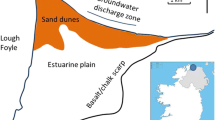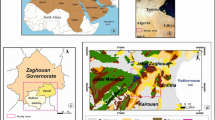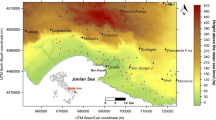Abstract
Intensive use of the Coastal Plain aquifer in Israel, as well as its ongoing contamination by agrochemicals and domestic and industrial waste, has resulted in the deterioration of its water quality. As a result, suggestions of abandoning this aquifer, which is a major source of potable water, have been seriously considered. The Coastal Plain aquifer is divided into a number of calcareous sandstone units separated by continental and marine lenses composed of silt and shale. Whereas the uppermost units are unconfined and are recharged directly from land suface by precipitation, wastewater, and runoff, the lower aquifers are partly confined. Although the presence of subaquifers is geologically well documented, the aquifer has been traditionally managed as a single water reservoir. The prevailing notion has been that the separation into subunits exists only up to 5 km from the shoreline, whereas, in the east, the aquifer is considered unlayered and uniform. However, hydraulic data, isotopic age determinations and variations in chemical composition, suggest that the clay lenses form an effective hydraulic partition between the different sand units, both in the western and eastern parts of the aquifer. The results of this study indicate that the prevailing conceptualization of the aquifer as one homogeneous water body is incorrect.
Similar content being viewed by others
References
Bachmat, Y., Ben Zvi, M., and Melul, A.: 1985, A Bayesian approach to the estimation of hydrological parameters, application to the Coastal aquifer, Rep. Hydro/3/1985 (in Hebrew).
Bear, J.: 1970, Interface movement in the Coastal Plain aquifer as a result of variations in water exploitation, Technion Institute for Research and development, Publ. No. 70/1, Haifa, (in Hebrew).
Bear, J. and Goldshlager, A.: 1971, The hydrological balance of a coastal aquifer, Technion Institute for Research and Development, Publ. No. 71/15, Haifa, (in Hebrew).
Ben Zvi, A.: 1993, Red lines for the Coastal Plain aquifer, a summary report, Israel Hydrological Service, Rep. Hydro/2/1993 (in Hebrew).
Ben Zvi, M.: 1977, The calculation of representative water levels for the USOM squares, Israel Hydrological Service, (in Hebrew).
Ben Zvi, M. and Bachmat, Y.: 1983, A Bayesian approach to the estimation of hydrological parameters, application to the Coastal aquifer Rep. Hydro/3/1983 (in Hebrew).
Essaid, H. I.: 1990, The computer model Sharp: a quasi three-dimensional finite difference model to simulate freshwater and saltwater flow in layered coastal aquifer systems, Water Resources Investigation Rep. 90-4130, U.S. Geological Survey.
Gerbi, Y.: 1992, A flow model for the coastal aquifer and its utilization for Sharon Dromi Region, Israel Hydrological Service, Rep. Hydro/3/1992 (in Hebrew).
Gieske, A. and De Vries, J. J.: 1985, An analysis of earth-tide induced groundwater flow in eastern Botswana,J. Hydrol. 82, 211–232.
Gordon, M. J. and Powell, R. L.: 1989, Identification of aquifer interconnection and continuity in a coastal plain geologic environment, inNew Field Techniques for Quantifying the Physical and Chemical Properties of Heterogeneous Aquifers, Proc. meeting organized by the Kerr Environmental research Laboratory, Dallas, Texas, pp. 35–52.
Israel State Comptroller,: 1990, A report on water management in Israel, State of Israel, (in Hebrew).
Israel Hydrological Service, 1988, A report on the hydrological status in Fall, 1987 and comparison with Fall 1986, unpaginated report (in Hebrew).
Issar, A.: 1961, The geology of the underground water resources in the Shefela and Sharon ares, PhD dissertation, The Hebrew University of Jerusalem, (in Hebrew).
Issar, A.: 1980, Stratigraphy and paleoclimates of the Pleistocene of central and northern Israel,Palaegeogr. Palaeoclim. Palaeoecol. 29, 261–280.
Jacob, C. A.: 1940, On the flow of water in an elastic arteasian aquifer,Trans. Am. Geophys. Union. 21, 574–586.
Kanfi, J. and Ronen, D.: 1976, The chemical quality of groundwater in the Coastal Plain aquifers, Israel, Israel Hydrological Service Report 76/1, Jerusalem (in Hebrew).
Kolton, Y.: 1988, Examination of the connection between groundwater and sea water in the Pleistocene aquifer along the continental shelf of the Mediterranean, central Israel, Water Planning for Israel LTD., Report 01/88/31, Tel Aviv (in Hebrew).
Melul, A.: 1988a, Hydrogeological atlas of Israel, Coastal Plain aquifer geometry and physical properties, Hydrological Service, Rep. Hydro 8/88, (in Hebrew).
Melul, A.: 1988b, The hydrological atlas of Israel, the Shefela Basin — geometry and physical features, Israel Hydrological Service Report 1988/6, (in Hebrew).
Melul, A. and Bibas, M.: 1990, The general and regional hydrological situation in the Coastal Basin and distribution of water quantities according to quality, Hydrological Service Report 1990/3 (in Hebrew).
Melul, A., Reingold, I., and Dax, A.: 1988a, Blocking and clogging of small diameter observation wells, Israel Hydrological Service Rep. Hydro 1988/3 (in Hebrew).
Melul, A., Vilner, A. and Goldberger, S.: 1988b, The design of water level monitoring network for the Coastal Plain aquifer, central area. Rep. Hydro 88/5, (in Hebrew).
Mercado, A.: 1989, A geochemical examination of the hydraulic connection between the Coastal aquifer and the sea, Tahal, 01/89/18, (in Hebrew).
Mercado, A., Avron, M., and Kahanovitch, Y.: 1975, Groundwater salinity in the Coastal Plain aquifer, Israel Hydrological Service Report 01/75/25, Jerusalem (in Hebrew).
Nativ, R. and Weisbrod, N.: 1994, Hydraulic connection among subaquifers of the Coastal Plain aquifer, Israel,Ground Water 32, 997–1007.
Rosenthal, E., Vinokurov, A., Ronen, D., Magaritz, M., and Moshkovitz, S.: 1992, Anthropogenic induced salinization of groundwater: A case study from the Coastal Plain aquifer of Israel,J. Contam. Hydrol. 11, 149–171.
Salama, R. B., Farrington, P., Bartle, G. A., and Watson, G. D.: 1993, Distribution of recharge and discharge areas in a first-order catchment as interpreted from water level pattern.J. Hydrol. 143, 259–277.
Swartz, Y.: 1988, A principal model for testing the remediation rate of the Coastal Plain aquifer, Tahal, Internal Pub.
Swartz, Y., Averbach, S., Blank, J., and Zelinger, A.: 1989, The remediation design of the Coastal Plain aquifer: simulation runs, Tahal, 01/89/21.
Tolmach, Y.: 1977,Hydrogeological Atlas of Israel- Geological Sections in the Coastal Plain Area, Volumes 1–6, Israel Hydrological Service, Jerusalem.
Van der Camp, G. and Gale, J. E.: 1983, Theory of earth tide and barometric effect in porous formations with compressible grains,Water resour. Res. 19, 538–544.
Zelinger, A., Levin, M., Blank, D., and Averbach, S.: 1988, Calibration of the simulation model for the Coastal Plain aquifer and update of the water balance, Tahal, 01/88/45.
Author information
Authors and Affiliations
Rights and permissions
About this article
Cite this article
Nativ, R., Weisbrod, N. Management of a multilayered Coastal aquifer — An Israeli case study. Water Resour Manage 8, 297–311 (1994). https://doi.org/10.1007/BF00872403
Received:
Accepted:
Issue Date:
DOI: https://doi.org/10.1007/BF00872403




